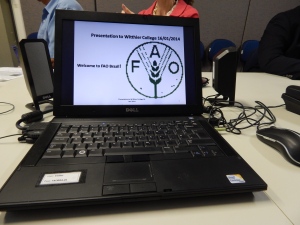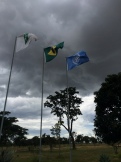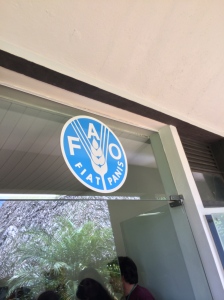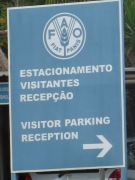Lara Cornelius

I had no idea the FAO had such a wide variety of projects and has been undergoing many internal changes recently. In 20110-2011 FAO implemented programs to a total value of 1.7 million. I think that in the upcoming years they should be able to implement even more programs such as the ones we heard about during the presentation because their annual budget is 1 billion US dollars. One specific change in their framework that stuck out to me is the way in which they manage their resources. Now they use “results based management” whereas before they were using “activity based management” which I believe is a change that MANY companies need to make when making assessments and allocating funds. This will result in an increase in productivity and significant long-term changes. It was also interesting to hear about some of the challenges they face such as farming systems, soil health, policies/institutions, and water resource management.
Isaiah Sneed
On Thursday we went to the Food and Agriculture Organization. At the FAO we learned about the different programs the organization was implementing both nationally and locally in order to try and eliminate world hunger and help create more productive crops. From the beginning I was impressed with the organization categorizing themselves as a knowledge share hub. From there I was informed on the vast amounts of research, education, and protection they provide to small farmers. Most notably the family farming program, which educated rural farmers to improve production, seemed to be very valuable ensuring that smaller farmers still had a place in Brazil’s economy.
Thomas Mehari
 The Food and Agriculture Organization (FAO) has been in Brazil for since about 1979. Since then, the organization has been working to fight hunger and poverty in Brazil and around the world which is a huge task. At our visit, the speaker talked about the current projects the organization has been working on. Besides their projects, the FAO also plays the role of consultant which has been increasing over time. In doing so, the organization has been able to reach more and more people. For Brazil, the organization has been focusing more on both and nutritional security. During 2010-2011, the organization had projects that cost about $1.7 billion. With that being said, they are definitely major steps on a quest to end hunger and poverty.
The Food and Agriculture Organization (FAO) has been in Brazil for since about 1979. Since then, the organization has been working to fight hunger and poverty in Brazil and around the world which is a huge task. At our visit, the speaker talked about the current projects the organization has been working on. Besides their projects, the FAO also plays the role of consultant which has been increasing over time. In doing so, the organization has been able to reach more and more people. For Brazil, the organization has been focusing more on both and nutritional security. During 2010-2011, the organization had projects that cost about $1.7 billion. With that being said, they are definitely major steps on a quest to end hunger and poverty.
Rebecca Raya
As a UNICEF volunteer for over five years, it was interesting to visit the Food and Agriculture Organization. The welfare of children worldwide has always been a topic of personal interest; it was reassuring to see the many projects implemented by FAO worldwide and in Brazil in efforts to reduce hunger and poverty. With over 194 member countries, the organization formed in 1945, continues to promote sustainable efforts in hopes of reducing hunger, poverty, and establish a global partnership for development. It was also very insightful to learn about their millennium goals, which is a set of eight goals benchmarked for 2015 in efforts to promote the mission of FAO.
Rachel Tegenkamp
DAY 8 – Thursday 1/16/2014
FAO:
 I really enjoyed visiting FAO today. I think that the issues that they deal with are super important and it obviously takes A LOT of work to organize and manage all of the programs that they do. I gained a new respect for the United Nations because I had no idea before how complex it actually is. I also like the fact that they use “results-based management.”
I really enjoyed visiting FAO today. I think that the issues that they deal with are super important and it obviously takes A LOT of work to organize and manage all of the programs that they do. I gained a new respect for the United Nations because I had no idea before how complex it actually is. I also like the fact that they use “results-based management.”
Shelden Agbayani
 Under the umbrella of UN, there is an organization that aids the prevention of hunger in developing countries. The Food and Agriculture Organization of Brazil uses initiatives to ensure the people of Brazil can eat. One of the most interesting initiatives they are doing is a UTF that improves the quality of aquaculture in the Amazon region. This is different because most initiatives in the Amazon region aid deforestation or food diversity. This put a different perspective on the Amazon because there are more issues than just deforestation in that region that needs to be addressed.
Under the umbrella of UN, there is an organization that aids the prevention of hunger in developing countries. The Food and Agriculture Organization of Brazil uses initiatives to ensure the people of Brazil can eat. One of the most interesting initiatives they are doing is a UTF that improves the quality of aquaculture in the Amazon region. This is different because most initiatives in the Amazon region aid deforestation or food diversity. This put a different perspective on the Amazon because there are more issues than just deforestation in that region that needs to be addressed.
Katryna Dillard
Thursday 1/16/2014: Our second stop of the day was at the Food and Agriculture Organization (FAO) where we learned all about projects taking place in Brazil dealing with farming and food. It was interesting to learn about their new five point strategic framework that is being implemented. I never really thought about non-profit organizations really having a framework or plan to fulfill their objectives and this presentation gave me a whole new outlook. We also had a speaker who was involved with the media relations of FAO which I also did not even consider to be a job that non-profits had to do. However, through the presentation I learned that by creating goals, working to achieve the goals, and showing the world through media a non-profit organization can be very successful and get more funds for other projects.
we learned all about projects taking place in Brazil dealing with farming and food. It was interesting to learn about their new five point strategic framework that is being implemented. I never really thought about non-profit organizations really having a framework or plan to fulfill their objectives and this presentation gave me a whole new outlook. We also had a speaker who was involved with the media relations of FAO which I also did not even consider to be a job that non-profits had to do. However, through the presentation I learned that by creating goals, working to achieve the goals, and showing the world through media a non-profit organization can be very successful and get more funds for other projects.
Katherine Lazo
01/16/2014: The visit to the FAO was definitely eye-opening in terms of how environmental and sustainability programs are implemented in Brazil. It was helpful in understanding the process and work that goes into the various programs and regulations. For much of the trip and through my readings I supported the different programs but after hearing about the research and communication and time that goes into them has now made me appreciate the work the FAO and other groups do to solve such issues as water management and farming systems.
Christiana Frisby
The United Nations group Food and Agriculture Organization has a $1 billion year budget. 41% comes from assessed contributors and 59% is from voluntary contributions. The presenter said, “In order to grow, agriculture must learn to save.” There has been a change in the trend of resources. Before, the north supplied resources to the south. Now, the south is now sharing its resources with the world. The speaker was very kind to share his time with us.
